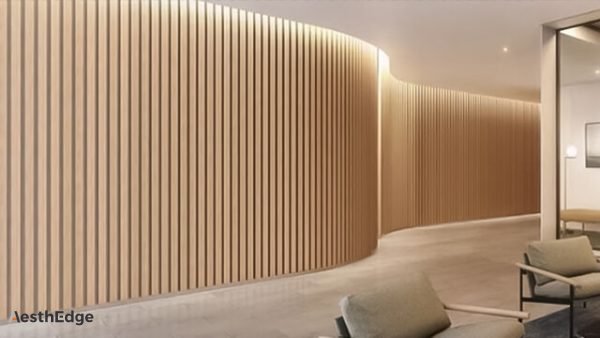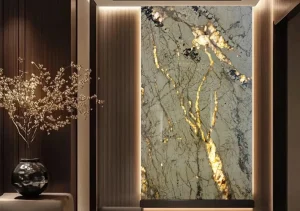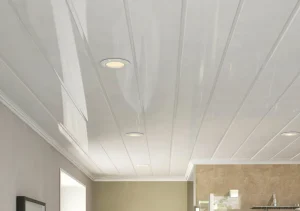Table of Contents
ToggleIntroduction: Understanding PVC vs uPVC Ceiling Panels
In the global interior decoration market, ceiling panels play a critical role in improving aesthetics, reducing maintenance needs, and enhancing long-term durability. With the growing demand for lightweight, waterproof, and cost-effective ceiling materials, PVC ceiling panels and uPVC ceiling panels have become two of the most widely used solutions—in residential, commercial, and industrial projects.
However, although they look similar in appearance, PVC (Polyvinyl Chloride) and uPVC (Unplasticized Polyvinyl Chloride) have significant differences in composition, performance, durability, price, fire resistance, and suitability for different environments.
For wholesalers, importers, building contractors, and interior product brands, understanding the differences between PVC and uPVC ceiling panels is essential to.

What Are PVC Ceiling Panels? Material & Properties Explained
1.Basic Definition
PVC ceiling panels are made from Polyvinyl Chloride resin mixed with:
- Plasticizers
- Stabilizers
- Calcium carbonate
- Color pigments
- Additives (UV stabilizer, anti-fungus agents, etc.)
Plasticizers are the key element that make PVC panels flexible.
2.Key Characteristics of PVC Ceiling Panels
PVC ceiling panels are known for:
- Flexibility
- Smooth surface finish
- Lightweight structure
- Waterproof and termite-proof
- Affordable cost
- Quick installation
- Wide decorative options
Because plasticizers increase elasticity, PVC panels are slightly softer and more bendable than uPVC.
3.Advantages of PVC Ceiling Panels
- 100% waterproof
- Lightweight and easy to install
- Wide color and texture options (marble, wood grain, matte, glossy, printed patterns)
- Lower production cost
- Suitable for low-budget projects
- Easy to cut and customize onsite
- Good for temporary or semi-permanent installations
- Resistant to humidity, stains, and mold
4.Limitations of PVC Panels
PVC ceiling panels are not perfect. Limitations include:
- Slightly lower rigidity compared to uPVC
- Lower fire resistance
- Easier to deform under high heat
- Not ideal for harsh outdoor or industrial environments
- Shorter lifespan compared to uPVC panels
In summary, PVC ceiling panels are flexible, economical, decorative, and ideal for general indoor use.
What Are uPVC Ceiling Panels? Material & Properties Explained
1.Basic Definition
uPVC means Unplasticized Polyvinyl Chloride or Rigid PVC.
Unlike regular PVC, uPVC contains no plasticizers, making it significantly harder, stronger, and more durable.
Typical uPVC formulation includes:
- PVC resin
- Stabilizers
- Titanium dioxide (for UV resistance)
- Lubricants
- Impact modifiers
- Calcium carbonate
Because there are zero plasticizers, uPVC is rigid and more dimensionally stable.
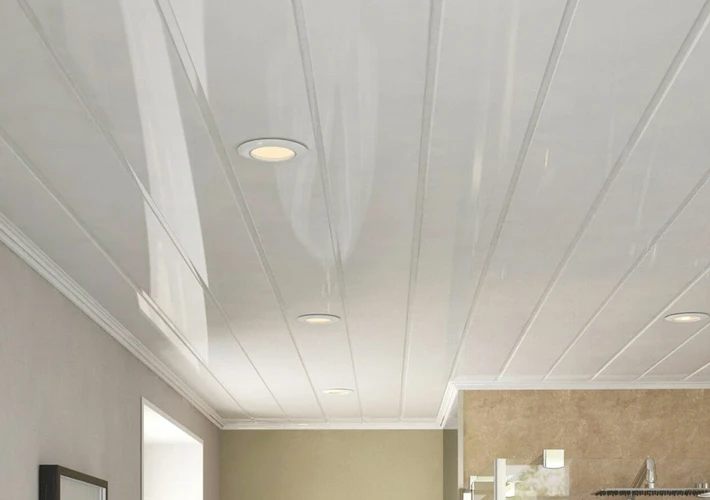
2.Key Characteristics of uPVC Ceiling Panels
uPVC ceiling panels offer:
- High rigidity and structural integrity
- Stronger impact resistance
- Better fire resistance
- Higher temperature resistance
- Longer lifespan (20–30 years)
- Better sound insulation
These features make uPVC panels a premium choice for demanding environments.
3.Advantages of uPVC Ceiling Panels
- Much stronger than PVC
- Better for hot climates or areas near heat sources
- Higher fire safety level
- Superior anti-aging performance
- Longer life span
- Resistant to yellowing and fading
- More stable, less expansion or deformation
- Suitable for high-end commercial projects
4.Limitations of uPVC Panels
- Higher cost
- Heavier than PVC, requiring better installation structure
- Less flexible—may crack if bent forcefully
- Limited design variety compared to PVC
- Cutting and fabrication require slightly more effort
In summary, uPVC ceiling panels are a rigid, long-lasting, fire-resistant solution ideal for premium projects.
PVC vs uPVC Ceiling Panels: Detailed Comparison (Material, Performance, Cost, Applications)
This section provides a full comparison to help wholesalers and project buyers clearly differentiate both materials.
1.Composition Difference
| Feature | PVC Ceiling Panels | uPVC Ceiling Panels |
|---|---|---|
| Plasticizers | ✔ Yes | ✖ No |
| Rigidity | Medium | High |
| Flexibility | High | Low |
| Durability | Medium | High |
| Heat Resistance | Medium | High |
Conclusion: Plasticizers make PVC flexible; uPVC is rigid and stronger.
2.Physical & Mechanical Properties
| Property | PVC | uPVC |
|---|---|---|
| Density | Lower | Higher |
| Strength | Moderate | High |
| Scratch Resistance | Lower | Higher |
| Impact Resistance | Medium | High |
| Dimensional Stability | Medium | High |
| Expansion Rate | Higher | Lower |
uPVC performs better structurally, especially in long-term installations.
3.Waterproof & Moisture Resistance
Both PVC and uPVC are 100% waterproof.
However:
- PVC may soften slightly in long-term humidity.
- uPVC remains rigid with better mold resistance.
For bathrooms, wet kitchens, and basements, both are suitable, but uPVC lasts longer.
4.Fire Resistance Comparison
uPVC ceiling panels have higher fire resistance because they contain no plasticizers.
PVC:
- May deform in high heat
- Slightly lower flame retardancy
uPVC:
- More stable at high temperatures
- Higher flame-retardant grade
- Safer for public buildings
For airports, hospitals, schools, hotels → uPVC is recommended.

5.Lifespan & Anti-Aging Performance
| Feature | PVC | uPVC |
|---|---|---|
| Lifespan | 8–15 years | 20–30 years |
| UV Resistance | Medium | High |
| Anti-Yellowing | Medium | High |
uPVC ceiling panels last significantly longer, especially in sunny or humid environments.
6.Installation Differences
PVC panels:
- Easy to cut
- Flexible for uneven ceilings
- Installation is quick
- Suitable for DIY projects
uPVC panels:
- Require more precise installation
- Heavier, requiring stronger framework
- Better dimensional stability
- Recommended for professional installers
7.Cost Comparison
| Item | PVC Ceiling Panel | uPVC Ceiling Panel |
|---|---|---|
| Raw Material Cost | Low | Medium-High |
| Manufacturing Cost | Medium | High |
| Market Price | $2–6 per piece | $4–12 per piece |
(Prices vary by country and specifications)
PVC is more cost-effective; uPVC is a premium product.
8.Application Comparison
PVC Ceiling Panels Applications
- Residential bedrooms
- Living rooms
- Rental apartments
- Low-budget renovations
- Shop ceilings
- Indoor decorative areas
- Temporary constructions
uPVC Ceiling Panels Applications
- High-end residences
- Hospitals
- Schools
- Commercial buildings
- Industrial facilities
- Coastal areas / humid climates
- Projects requiring fire-rated materials
Pros & Cons of PVC vs uPVC Ceiling Panels (Full Analysis)
PVC Ceiling Panels Pros
- Low cost
- Easy to install
- Lightweight
- More design variety
- Good flexibility
- Suitable for most indoor environments
- Great for mass-volume B2B projects
PVC Ceiling Panels Cons
- Lower fire resistance
- Less durable
- May deform at high temperature
- Shorter lifespan
- Not ideal for heavy-duty environments
uPVC Ceiling Panels Pros
- Excellent rigidity
- High strength
- Fire-resistant
- Long lifespan
- UV and weather resistant
- Suitable for professional projects
- Premium appearance and performance
uPVC Ceiling Panels Cons
- Higher price
- Limited color options
- Not as flexible as PVC
- Requires professional installation
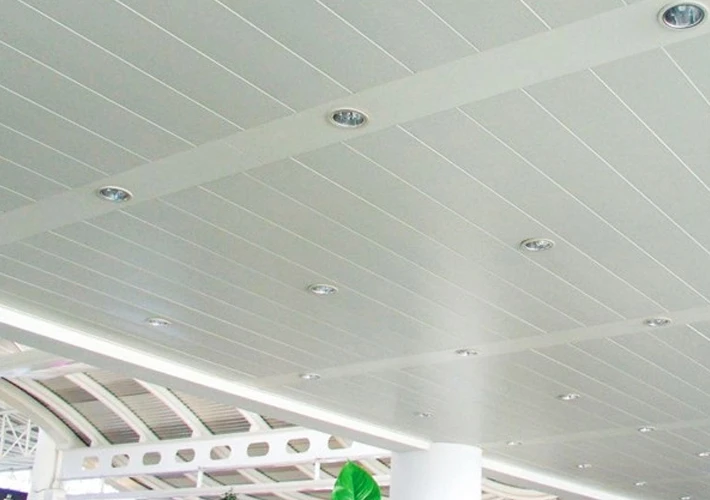
How to Choose Between PVC and uPVC Ceiling Panels? (Expert B2B Buying Guide)
1.Choose PVC when:
- You want a cost-effective material
- You need a decorative ceiling for indoor areas
- You prefer rich colors and patterns
- The project is budget-sensitive
- Installation needs to be quick and simple
Best for:
– Residential projects
– Retail stores
– Renovation contractors
– Rental apartments
– Large-scale decorative projects
2.Choose uPVC when:
- Durability and safety are top priorities
- Fire-resistance standards are required
- You need higher strength
- Installation environment is harsh
- You want long-term, maintenance-free ceilings
Best for:
– Hospitals, airports, schools
– Hotels and commercial buildings
– Industrial plants
– High-end residences
– Humid coastal areas
3.For Importers & Wholesalers
Consider the following factors:
- Local building codes
- Target customer market (budget vs premium)
- Stock turnover cycle
- Preferred panel sizes (usually 250mm, 300mm, 600mm)
- Shipping volume and load capacity
- Color popularity by region
Offering both PVC and uPVC ceiling panels helps you serve a wider market.
4.Quality Inspection Tips
When sourcing from China, check:
- Thickness consistency
- Panel straightness
- Surface finish quality
- Scratch resistance
- Fire test performance
- UV resistance (TiO₂ percentage)
- Weight per meter (indicates density & quality)
Top factories provide:
- ISO certifications
- In-house testing reports
- UV-aging test data
- Fire rating documents
Conclusion: Which Is Better—PVC or uPVC Ceiling Panels?
PVC and uPVC ceiling panels serve different needs:
- PVC ceiling panels → affordable, decorative, flexible, best for general indoor use.
- uPVC ceiling panels → strong, durable, fire-resistant, ideal for high-end or commercial applications.
For wholesalers and project contractors, the right choice depends on budget, performance requirements, installation environment, and customer expectations.
Both materials will continue growing in global demand due to their waterproof nature, lightweight structure, and versatility.

